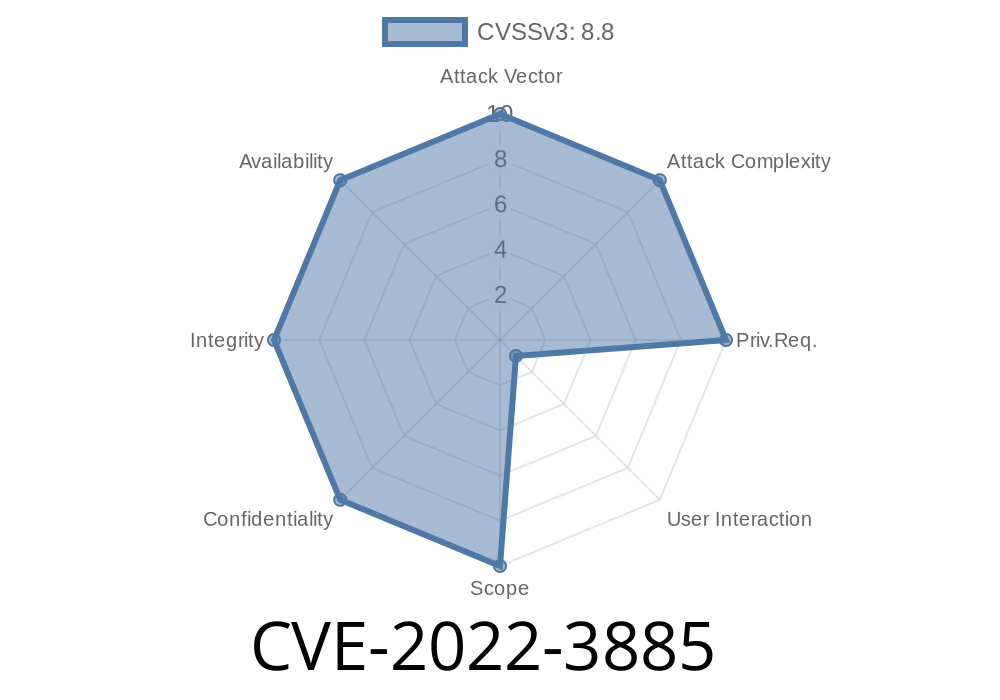The Google Chrome web browser relies heavily on the V8 JavaScript engine to power its core functions. However, it has come to light that Chrome versions prior to 107..5304.106 contained a potentially dangerous vulnerability classified as a "use-after-free" exploit in the V8 engine. This vulnerability, known as CVE-2022-3885, could allow remote attackers to take advantage of heap corruption through specifically crafted HTML pages. In this post, we will dive into the details of this exploit, including code snippets and links to original references, to provide a comprehensive explanation of the issue and its severity.
Understanding Use-After-Free and Heap Corruption
Before getting into the specifics of CVE-2022-3885, it is important to understand what a "use-after-free" vulnerability is and how it can lead to heap corruption. A "use-after-free" vulnerability occurs when a program continues to use a pointer after the memory it points to has been freed. When this memory location has been released (or "freed"), it can be reallocated for other purposes, potentially allowing an attacker to manipulate the data stored in that location. Heap corruption, in turn, may occur as a result of the incorrect or malicious manipulation of the memory heap, which can lead to unexpected behavior, crashes, or even code execution by a remote attacker.
The CVE-2022-3885 Vulnerability
Google Chrome's vulnerability (CVE-2022-3885) is caused by an error in the V8 JavaScript engine's handling of memory allocation and release, which could potentially result in heap corruption. By creating a crafted HTML page, a remote attacker can exploit this vulnerability and gain unauthorized access to sensitive data, cause denial of service, or execute arbitrary code on the victim's machine.
The following code snippet demonstrates a basic example of how the vulnerability can be exploited
<!DOCTYPE html>
<html>
<head>
<script>
function exploit() {
// Corrupted object creation
let obj1 = {a: 1, b: 2};
obj1.__defineSetter__("x", function() {
// Object destruction
delete obj1.a;
delete obj1.b;
});
// Trigger the object property setter
obj1.x = 42;
// Attempt to access freed memory
try {
for (let i = ; i < 100; i++) {
if (obj1.a === undefined) {
// Trigger the use-after-free vulnerability
let newObj = {y: obj1};
}
}
} catch (e) {
console.log("The use-after-free vulnerability could not be triggered.");
}
}
</script>
</head>
<body>
<button onclick="exploit();">Trigger Exploit</button>
</body>
</html>
In this example, the exploit function causes the program to attempt operations on the obj1 object after its properties (a and b) have been deleted. This situation creates a use-after-free vulnerability that an attacker could exploit to potentially wreak havoc.
Original References and Severity
The CVE-2022-3885 vulnerability was originally reported by the Chromium team and has been assigned a "high" security severity rating. The Chromium project includes detailed information about the vulnerability and its potential impact in the following resources:
- Chromium issue 1373645
- Google Chrome Releases
- National Vulnerability Database (NVD): CVE-2022-3885
Mitigation and Prevention
To protect against this vulnerability (CVE-2022-3885), it is crucial that users update their Google Chrome web browser to version 107..5304.106 or later. Doing so will ensure that the V8 JavaScript engine is updated to a version without the use-after-free vulnerability. Additionally, users should exercise caution when visiting untrusted websites or clicking unknown links, as they may potentially host crafted HTML pages designed to exploit this vulnerability.
In Conclusion
CVE-2022-3885 represents a serious security risk for unpatched versions of Google Chrome, as it could enable remote attackers to exploit heap corruption through crafted HTML pages and potentially gain unauthorized access to sensitive information, cause denial of service, or execute arbitrary code. However, by understanding the vulnerability and taking appropriate steps to update the affected software, users can safeguard their systems and ensure robust protection against this threat.
Timeline
Published on: 11/09/2022 04:15:00 UTC
Last modified on: 11/14/2022 15:15:00 UTC
